Translation and analysis of words by ChatGPT artificial intelligence
On this page you can get a detailed analysis of a word or phrase, produced by the best artificial intelligence technology to date:
- how the word is used
- frequency of use
- it is used more often in oral or written speech
- word translation options
- usage examples (several phrases with translation)
- etymology
gutter-child - translation to russian
['gʌtə|tʃaild]
существительное
общая лексика
беспризорный ребёнок
беспризорный ребенок
Definition
Wikipedia

In philately, a gutter is the space left between postage stamps which allows them to be separated or perforated. When stamps are printed on large sheets of paper that will be guillotined into smaller sheets along the gutter it will not exist on the finished sheet of stamps. Some sheets are specifically designed where two panes of stamps are separated by a gutter still in the finished sheet and gutters may, or may not, have some printing in the gutter. Since perforation of a particular width of stamps is normal, the gutter between the stamps is often the same size as the postage stamp.
Several derivative terms exist:
- Gutter pairs are two stamps separated by a gutter.
- Gutter block is a block of at least four stamps where either the vertical or horizontal pairs, or both, are separated by a gutter.
- Gutter margin is a margin dividing a sheet of stamps into separate panes.



![Decorative lead hopper head dated 1662, [[Durham Castle]] Decorative lead hopper head dated 1662, [[Durham Castle]]](https://commons.wikimedia.org/wiki/Special:FilePath/2017-09-13 Durham Castle drainpipe.jpg?width=200)








